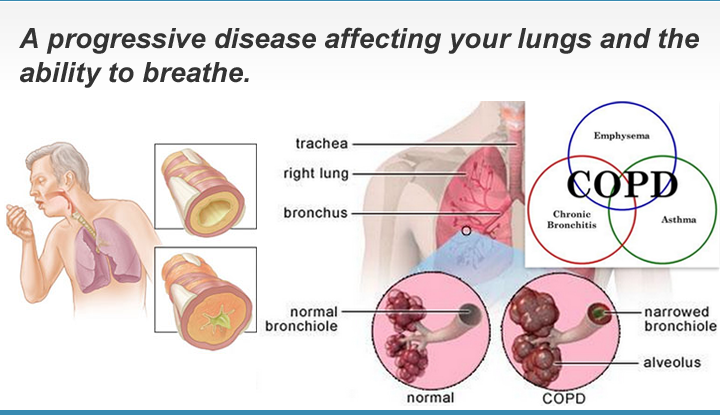COPD

Chronic Obstructive Pulmonary Disease is an umbrella term used to describe progressive lung diseases including emphysema, chronic bronchitis, refractory (non-reversible) asthma, and some forms of bronchiectasis. This disease is characterized by increasing breathlessness.
Many people mistake their increased breathlessness and coughing as a normal part of aging. In the early stages of the disease, you may not notice the symptoms. COPD can develop for years without noticeable shortness of breath. You begin to see the symptoms in the more developed stages of the disease. That’s why it is important that you talk to your doctor as soon as you notice any of these symptoms. Ask your doctor about taking a spirometry test.
What are the symptoms?
- Increased breathlessness
- Frequent coughing (with and without sputum)
- Wheezing
- Tightness in the chest
How common is COPD?
COPD affects an estimated 24 million individuals in the U.S., and over half of them have symptoms of COPD and do not know it. Early screening can identify COPD before major loss of lung function occurs.
What are the risk factors?
Most cases of COPD are caused by inhaling pollutants; that includes smoking (cigarettes, pipes, cigars, etc.), and second-hand smoke.
Fumes, chemicals and dust found in many work environments are contributing factors for many individuals who develop COPD.
Genetics can also play a role in an individual’s development of COPD—even if the person has never smoked or has ever been exposed to strong lung irritants in the workplace.
Here is more information on the top three risk factors for developing COPD:
Smoking
COPD most often occurs in people 40 years of age and older who have a history of smoking. These may be individuals who are current or former smokers. While not everybody who smokes gets COPD, most of the individuals who have COPD (about 90% of them) have smoked.
Environmental Factors
COPD can also occur in those who have had long-term contact with harmful pollutants in the workplace. Some of these harmful lung irritants include certain chemicals, dust, or fumes. Heavy or long-term contact with secondhand smoke or other lung irritants in the home, such as organic cooking fuel, may also cause COPD.
Genetic Factors
Even if an individual has never smoked or been exposed to pollutants for an extended period of time, they can still develop COPD. Alpha-1 Antitrypsin Deficiency (AATD) is the most commonly known genetic risk factor for emphysema2. Alpha-1 Antitrypsin related COPD is caused by a deficiency of the Alpha-1 Antitrypsin protein in the bloodstream. Without the Alpha-1 Antitrypsin protein, white blood cells begin to harm the lungs and lung deterioration occurs. The World Health Organization and the American Thoracic Society recommends that every individual diagnosed with COPD be tested for Alpha-1. For more information about AATD and how to get tested, visit the ALPHA-1 FOUNDATION WEBSITE or call 1-877-2 CURE-A1.
Because not all individuals with COPD have AATD, and because some individuals with COPD have never smoked, it is believed that there are other genetic predispositions to developing COPD. Read about the COPDGENE™ STUDY to learn about research to find other genetic causes of Chronic Obstructive Pulmonary Disease.
Taken from COPD Foundation
Getting Tested
A person may have Chronic Obstructive Pulmonary Disease (COPD) but not notice symptoms until it is in the moderate stage. This is why it’s important to ask your doctor about taking a breathing test (called spirometry) if you are a current or former smoker, have been exposed to harmful lung irritants for a long period of time, or have a history of COPD in your family, such as ALPHA-1 ANTITRYPSIN DEFICIENCY related COPD.
A spirometry test measures how well your lungs are working. It’s a simple and easy test that can help diagnose COPD.
Who should get tested for COPD?
If you have any of these SYMPTOMS, you are at risk for developing COPD.
Anyone with the following should get tested:
- Has a history of smoking
- Has long-term exposure to air pollutants (including pollution and second-hand smoke)1
- Has chronic coughing with or without sputum
- Has wheezing
- Has shortness of breath that has become worse over time
- Cannot keep up with people of your own age
Spirometry is a simple, non-invasive test that is used to diagnose COPD. When you take the test, you will be asked to blow all the air out of your lungs into a mouthpiece connected to a machine known as a spirometer.
The machine will calculate two numbers: the amount of air you blow out in the first second, and the amount of air you blow out in 6 seconds or more.
Why is it important to get tested?
Leaving symptoms misdiagnosed, untreated, or undertreated may cause them to worsen faster than if they were treated with proper medication and therapy. Many adults are incorrectly diagnosed with asthma. Providing a proper diagnosis means individuals will receive the right treatments and follow up monitoring. There’s no cure yet for COPD but treatments are available to help individuals live better.
.
